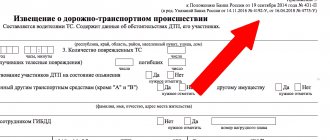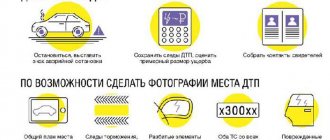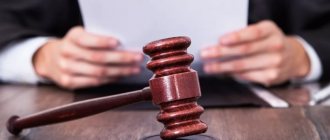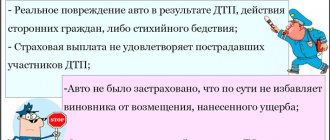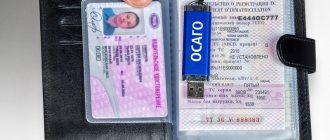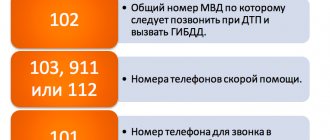Important change from May 1, 2019
The main risk of failure to fulfill this obligation under the European protocol before the specified date was that this gave the insurance company the right to issue recourse to the culprit.
But as of May 1, 2019, this consequence for the guilty driver was abolished. The corresponding Federal Law No. 88-FZ was issued, as a result of which the corresponding subparagraph “G” of paragraph 1 of Article 14 in the law On Compulsory Motor Liability Insurance became invalid. Therefore, if your particular insured event in the form of an accident occurred after May 1, 2021, and you missed 5 working days to notify the insurance company about this, then the recourse will be illegal.
In what cases is a European protocol issued in 2021?
Registration of the European protocol allows not only to clear the roadway for the free movement of other cars in the shortest possible time, but also to save drivers’ finances.
When calling the traffic police, violations committed by drivers before the incident will be identified, and fines will be imposed accordingly. Drawing up a European protocol is much more convenient than calling the traffic police, but it is not available in every incident. The procedure is possible if a minor accident occurred in which no one was injured.
The European protocol is valid in every region of the country without exception.
You are allowed to resolve the issue yourself using the European protocol if:
- no more than two cars were involved in the accident;
- as a result of the incident there are no injuries requiring medical attention;
- there is no property damaged as a result of the incident, except for the two cars involved in the accident;
- both drivers have a valid MTPL policy;
- the amount of damage caused does not exceed 100,000 rubles;
- agreement was reached regarding the culprits, the circumstances of the incident and the nature of the damage.
Drawing up a European protocol if there is disagreement between drivers regarding the circumstances of the incident is possible if one of the cars is equipped with the GLONASS system or the Europrotocol application. These devices are designed to record and transmit data about what happened. It is impossible to change or correct the information recorded by the devices.
When there are casualties or secondary damage to other vehicles occurs, it is imperative to call the road service.
What kind of law?
So, if the accident was registered according to the European protocol, then both the culprit and the victim are still obliged in 2021 to send each their notice to the insurance company within 5 working days. This is regulated by the Federal Law “On Compulsory Motor Liability Insurance”.
If the victim does not do this, this will not be a basis for refusing the culprit. But if the culprit does not provide such a notice, then he was previously subject to recourse - that is, the victim received a payment, but then the insurance company recovered the entire paid amount, up to 100 thousand, from the culprit.
2. In case of registration of documents about a road traffic accident without the participation of authorized police officers, the form for notification of a road traffic accident, filled out in duplicate by the drivers involved in the road traffic accident of vehicles, is sent by these drivers to the insurers who insure their civil liability , within five working days from the date of the traffic accident .
And here is an excerpt from the Federal Law “On Compulsory Motor Liability Insurance” on the right of recourse from the insurance company to the culprit of an accident:
1. The right of claim of the victim against the person who caused the harm in the amount of the insurance compensation provided to the victim is transferred to the insurer who has provided the insurance compensation, if: .... g) the specified person, in the case of processing documents about a road traffic accident without the participation of authorized police officers, did not send to the insurer that insured his civil liability a copy of the notification form about a road traffic accident completed together with the victim within five working days from the date of the road traffic accident transport accident;
(subclause no longer in force as of May 1, 2021)
Characteristics of the Europrotocol in case of road accidents
The concept of “Europrotocol” is not legal and has no legislative support.
The method of registration of traffic accidents that we are considering was borrowed by the domestic legislator from abroad.
It is based on a model developed and widely used in a number of European countries.
In domestic legislation, the procedure for registering an accident without the participation of authorized police officers is regulated in Article 11.1 of the Federal Law of the Russian Federation “On OSAGO” as amended by Federal Law No. 223 of July 21, 2014.
Over the years of application of the Europrotocol when registering road accidents, the share of losses settled through the use of this procedure is less than 9 percent of the total number of insured cases.
This low figure is due to the fact that it is difficult for participants in road accidents to objectively assess the amount of damage caused at the scene of the incident.
The risk that the established limit of insurance compensation will not be enough to fully repair the damaged car deters victims from applying the Europrotocol in case of an accident.
Currently, amendments to the law “On Compulsory Motor Liability Insurance” introduced by Federal Law No. 223 of July 21, 2014 have increased the amount of insured amount under the Europrotocol to 50,000 rubles.
From October 1, 2014, the limitation on the amount of the insurance amount when settling losses according to the rules of the Euro Protocol does not apply if a traffic accident is registered in the territories of the Moscow and Leningrad regions, as well as in federal cities - Moscow and St. Petersburg in the manner and on the conditions provided for in paragraph 5 of Article 11.1 of the Federal Law “On Compulsory Motor Liability Insurance”.
These innovations are designed to encourage drivers involved in accidents to independently file an accident, which will partially solve the problems of traffic congestion.
Related article:
The order and sequence of actions of the driver when registering an accident
Why is the law on 5 days to provide a European protocol so categorical?
Although such an obligation of the culprit to provide a European protocol within 5 days looked like an obvious loophole for insurance companies to enrich themselves at the expense of recourse to the culprit, there is still some logic here. The fact is that when registering an accident using a European protocol, police officers are not involved, and the recording of the accident, its nature, circumstances and damage is carried out by the participants themselves.
Due to the absence of police officers during road accidents, the risk of fraud with false road accidents increases significantly. According to the Civil Code, the victim has the right to apply for payment within the general limitation period (yes, the law “On Compulsory Motor Liability Insurance” explicitly states a period of 15 days for notification of an accident, but this obligation of the victim does not affect anything), which is 3 years. And, if the victim applies after 3 years, then it will be almost impossible to establish by the nature of the damage their involvement in this particular accident. And if traffic police officers had been involved, they would have recorded the damage.
Actions after compilation
An accident occurs in which one of the drivers realizes that he is the culprit. Naturally, the question arises as to whether it is necessary to call a traffic police officer. To solve it, first of all, the real situation is assessed:
- participation of only 2 cars;
- absence of serious injuries among drivers, passengers, pedestrians;
- severity of damage.
Further, in order to make a decision in favor of the Europrotocol, one should realistically assess the degree of damage to the damaged vehicle. You should not trust only the opinion of the other party. The victim may make a mistake when giving the amount, or deliberately underestimate it in order to exclude depreciation from being taken into account when determining the repair bill.
Find out more details about what the culprit and the victim should do after drawing up the European Protocol in case of an accident, and where to contact the victim in an accident in a separate article.
Do I need to go to the insurance company?
The right to resolve this issue remains with the policyholder. In accordance with the MTPL Law, he is obliged to report the incident and send a Notice to the insurer, but how he does this is not regulated. The culprit of an accident can do the following:
- Personally visit the company's office and hand over the Notice. In this case, it is important to remember that the fact of transfer must be clearly recorded. You should definitely keep a copy of the Europrotocol with you, and receive a document indicating the date of receipt from the person who accepted the original Notification.
- If the culprit cannot take the document to the insurance company himself, he can send a Notice to the insurer by registered mail with return receipt requested. An inventory of the attachment must be compiled at the post office.
The person at fault for the accident must take into account that during a possible trial, he must provide irrefutable evidence that the insurer received the Notification of the accident, and in a timely manner. Naturally, reporting an incident by telephone cannot be considered a full notification.
Responsibilities
In accordance with the current rules for drawing up the Euro Protocol, the culprit of the accident is obliged to take the following measures:
- Together with the injured party, fill out the accident notification form (as the Europrotocol is correctly called). The document has 2 identical halves, after dividing which one remains with the victim, and the other with the culprit of the accident.
- Fill out the back of your half of the form. Find out more about preparing a notification of an accident according to the European Protocol here.
- Send your half of the Europrotocol to the insurance company no later than 5 days after the accident (find out more details about the deadline for submitting a notice to the insurance company here). You can submit the notice by visiting the company's office in person or by sending it by mail, but the sooner this happens, the better.
- After the accident, the culprit of the accident is obliged not to repair or dispose of the car for 15 days. This requirement is established by subparagraph “h” of paragraph 1 of Article 14 of the “Law on Compulsory Motor Liability Insurance”. In addition, upon first request, he must provide the car for inspection by the insurer's experts within 5 days.
A receipt from the victim will help avoid additional payments to the culprit. In it, he must clearly indicate that the amount of his claim cannot exceed the maximum insurance payment under the Euro Protocol. It is advisable to indicate additional information in the receipt:
- date and description of the accident;
- information about both vehicles and drivers, including information about their driving licenses.
The receipt will have good legal support if there are two witnesses.
What to do if you did not have time to submit the European protocol within 5 days?
Important! Didn't receive an answer to your question? Our expert lawyers work for you. It's absolutely free!
- Only practicing traffic lawyers
- Anonymously
- For free
or call toll free number 8
✖
If you are the culprit and did not have time to submit a European report to the insurance company within 5 days, then there are chances to challenge the recourse, but they are very small if the accident occurred before May 1, 2019. The fact is that any law must be based on logic and a motivated part introduction of this or that rule. And, if you prove that the nature of the victim’s injuries is beyond doubt (of course, this can only happen if the victim himself contacted the insurance company within a reasonable time), then the court can take this into account and reconsider the decision on recourse.
But the chances of such an outcome if you have not provided the European protocol within 5 working days are extremely small, since, firstly, you will have to prove the opposite of what is clearly stated in the legislation, and, secondly, such a judge’s decision may entail the abolition of this very interpretation of the law, and not every judge will take on such responsibility.
And yet there are several court decisions in judicial practice when the recourse was won. One of them is based on the fact that the liability of both the culprit and the victim was insured by the same company (Ingosstrakh), and therefore the insurer’s claim was rejected on the basis that in this case the latter did not bear any risks and nothing It wouldn’t have changed if the culprit had presented the European protocol on time.
How does the traffic police investigate an incident?
If the inspector considers that additional measures need to be taken to resolve the issue of qualification of actions and the degree of culpability of participants in a road accident, the material will be sent to the local traffic police department for accident investigation.
We suggest you read: Renaissance loan, is it possible to refuse insurance?
Next, a special group of employees is appointed to analyze the circumstances of the incident. Participants are notified in advance of the date and time when a specific situation will be dealt with, if this was not done directly at the scene of the accident.
Each specific case uses its own methodology for investigating an accident, but there are some points that any driver needs to know.
- The investigation is preceded by a study of case materials collected at the scene of the accident and an interview with eyewitnesses. The main object of the investigation at the preliminary stage is the documents recording the fact of the incident. Typically, it takes 3-30 days to review written evidence.
- Often, to restore the mechanism of an accident, it is necessary to conduct an examination, for example, traceological or auto technical. If inspectors involved in the analysis of road accidents avoid ordering examinations, explaining this by the workload of the service, the interested driver should insist on having them carried out.
- During the analysis, the case officers clarify the details both on the basis of written documents and oral conversations with each driver. Participants in the accident may be invited simultaneously or heard separately. In the first case, a kind of confrontation is carried out, since giving false testimony in an accident is a fairly common case.
- Often inspectors do not allow drivers to familiarize themselves with the case materials and do not show a diagram of the incident. On the one hand, this is a way to push the participants in the accident to independently remember the nuances of the accident and contributes to an objective consideration of the case, and on the other hand, it is a veiled method to help the “liked” driver.
As a result of the analysis of the car accident, the group’s inspectors draw conclusions about the presence of elements of an offense in the actions of the participants in the accident, and determine its nature. Based on the findings, a decision is made on a specific incident.
Since no driver is immune from troubles on the road, if a car accident occurs and you are sent to the traffic police to investigate the accident, you need to know how to behave. You should not leave the solution to a serious issue to chance; it is better to carefully prepare for the investigation and think about how to prove your innocence in an accident and defend the correctness of your vision of what happened.
Participants in an accident have the right to familiarize themselves with all documentation on the case. You can view the available materials in advance. To do this, you must ask the investigation officer to provide all the documents drawn up by the inspector during the accident. In addition, the testimony of interviewed witnesses, video and photographic materials should be studied.
When preparing to analyze an accident, a diagram of the accident scene may be useful. You should not rely on your memory, since many drivers are under stress at the time of the incident and may not remember essential details: the location of signs, the position of the car relative to the road infrastructure, markings on the road, the location of transport stops.
During the analysis, participants in the incident are granted the following rights.
- If necessary, the driver can ask the investigator to appoint an examination of the case or request certificates from the relevant services that control the lighting and condition of the road surface at the scene of the accident.
- A foreigner must be provided with an interpreter.
- Present any evidence taken/collected at the scene of the incident: photographs, video footage from a DVR or mobile phone, explanations of eyewitnesses, and also demand that they be included in the material.
- Submit petitions.
- Conduct audio recording during the analysis of an accident.
- If you disagree with the result of the investigation, appeal the decision.
Important: the appeal period is counted from the date when the driver received a copy of the decision. Therefore, you should not sign the document in the past date.
When analyzing an accident by traffic police officers, especially in difficult cases, legal assistance in road accidents will be useful. It is advisable to invite an experienced and competent lawyer to the scene of the incident. As a rule, in serious car accidents there are victims, the cause-and-effect relationship in the accident is not determined, or the drivers are mutually guilty of committing a traffic offense.
What else could there be a recourse from the insurance company under the European protocol?
Yes, the failure of the culprit to submit his copy of the European protocol was abolished. But there are a number of other conditions, if not met, the culprit may be billed in the amount paid to the victim:
- if it is proven that the harm was caused intentionally in the presence of harm to the health or death of the victim (if you deliberately crashed into the victim);
- if at the time of the accident the culprit was drunk;
- if the culprit was not included in the MTPL policy or did not have the right to drive the car he was driving at the time of the accident;
- the culprit repaired or disposed of the car within 15 days after the accident without providing it for inspection by the insurance company;
- if the diagnostic card has expired - only for passenger taxis, buses, trucks with more than 8 seats or vehicles equipped for the transport of dangerous goods.
What to do if the culprit of the accident does not admit his guilt
The actions of the culprit after registration of an accident will differ slightly depending on whether the driver has a CASCO policy in addition to compulsory motor liability insurance or only the second one.
If the culprit of a traffic accident has only a compulsory motor liability insurance policy, the procedure will be as follows:
- take a video or photo of the accident in the presence of the victim: the damage to the cars after the accident, their position and everything related to the incident should be visible;
- it is necessary to write down the contact and passport details of the victim (i.e. the owner of the car), if there are witnesses, their data is also needed during registration;
- it is necessary to exchange data on MTPL policies; if the victim has CASCO insurance, then his number, etc. should also be written down;
- Next, both participants in the accident need to issue a notification about the traffic accident, and the person responsible for the accident needs to make sure that the victim signs the notification;
- the culprit needs to find out when the case of an accident will be considered, if it is considered on the spot by police officers, then take part, and if you disagree with the decision, write “disagree” under your own signature and state your version of what happened (any result of the consideration of the case can be challenged within 10 days after registration of a traffic accident);
- Next, you need to obtain a protocol of an administrative violation, a certificate of an accident and a resolution on an administrative violation; on each of the documents you should immediately check whether they are filled out correctly and whether all signatures are in place;
- you cannot promise the victim to compensate for the harm, in any form - neither verbally, nor in writing, nor directly or indirectly;
- the person at fault for the accident needs to monitor how the process of collecting and submitting the victim’s documents to insurers is progressing;
- It is necessary to separately photograph all the damage to the culprit’s car, since disagreements between the parties are likely after the accident is registered;
- there is no need to refuse to inspect the victim’s car, you should do it carefully and, in case of disagreement with the experts, write all comments in the report.
Attention! If you have any questions, you can chat for free with a lawyer at the bottom of the screen or call:
7
Moscow;
7
Saint Petersburg;
7
Free call for all of Russia.
- strictly follow the rules and deadlines specified in the CASCO agreement;
- write an application for insurance payment under the policy, and after its acceptance and registration, make a copy with the date of acceptance and signature of the employee;
- find out the insurance case number, which will help you receive information about its settlement in the future;
- obtain a referral from insurers to inspect the car and present it on the specified date;
- make copies of all documents that must be presented to insurers, or better yet, obtain from the employee a list of accepted papers with his signature.
If there was no payment under CASCO after the accident was registered, or it does not cover repairs, you should go to court, and also file a complaint with the insurance supervision.
To submit an application to the insurance company for compulsory motor liability insurance after registering a traffic accident, you must prepare the following package of documents:
- certificate of accident, if it was not issued according to the European Protocol;
- notification of an incident;
- protocol of administrative violation;
- paper on the ownership of the car;
- resolution in a case of administrative violation;
- driver's license or power of attorney for the car;
- bank details;
- OSAGO policy.
The driver may also need the following documents:
- if there was an independent examination, its conclusion on the amount of damage will be required;
- papers confirming payment for the work of an independent expert;
- If the car has been towed, documents about evacuation and storage are needed.
When handing in papers, you must keep a copy of each for yourself. In addition, they must be accepted according to the inventory.
The correct actions of drivers who fall into this category are extremely important. Since not everyone who causes an accident clearly understands what to do with the insurance company responsible for the accident, some of them may not report the incident. It is the responsibility of the person at fault to notify your insurance company. This requirement is established by Article 11 of OSAGO. Otherwise, the insurer may either refuse to pay or recover through court the amount of its costs from the culprit.
We suggest you read: How to cancel a car loan after signing an agreement
When talking with a representative of the insurer, the driver must inform him that he is the culprit of the accident and provide the following information:
- number of road accident participants;
- place and time;
- data on vehicles (numbers, brands, production dates);
- information about the presence of victims and injured people, as well as their condition.
Sometimes during an accident a controversial situation arises in which it is difficult to identify the offender, or he refuses to admit his guilt. Many do not know what to do in this case and make the situation unacceptable. In this case, the correct procedure if the culprit does not admit his guilt is the following algorithm:
- leave the car in its original condition, but you need to turn on the hazard lights and put special signs on the road;
- call a traffic police officer to record the incident;
- contact the insurance company;
- contact the traffic police to document all the facts that influence the court's decision on the person at fault - witnesses to the incident must also come and provide their testimony.
In a situation where the offender does not admit his guilt, it is better to seek the help of a competent lawyer. Sometimes traffic police officers offer to wait two months and come to an agreement with the culprit, because after this period a protocol on the administrative violation can no longer be drawn up. But this is fraught with problems with obtaining compensation from the insurer, because all companies require the immediate provision of documents regarding the accident.
Sometimes it happens that the culprit, who previously admitted his guilt, subsequently retracts his words and goes to court. In this case, the victim will have to prove his case through this government body. This procedure may take several months.
The refusal of the violator to admit his responsibility is a common practice, because under compulsory motor liability insurance payments are due only to the victim. Therefore, it is important to independently video and photograph the scene of the accident, give clear testimony when drawing up a protocol, and keep copies of documents about the accident.
Establishing the degree of guilt of participants in an accident is an important problem. Who is to blame for an accident when one car was going at a high speed on a green light, and the other was going at the speed limit on a red light? The answer is not clear.
The culprit of a traffic accident can be determined either at the scene of its occurrence or in court. If people were injured in the accident, only the court will determine guilt.
Any car accident causes a lot of stress for those involved. Immediately after a collision, it is quite difficult to control your actions and emotions. There are often cases when the victim admits his guilt in an accident. When under stress, a person feels guilty about what happened. The opposite side also insists on his guilt, and he admits it.
In this situation, do not rush to jump to conclusions.
Demand that all facts in your favor be entered into the protocol and prepare for trial. If you are convinced of your guilt, and the punishment does not involve imprisonment and is acceptable to you financially, then admit guilt to avoid wasting time on legal proceedings.
What to do if the person responsible for the accident does not admit his guilt? Prepare for trial and require proper inspection of the scene and recording of important facts. Conducting an independent auto examination is a legal way to identify the real culprit of an accident and evaluate the event.
In a court
You will have to establish guilt in an accident in court if at the scene of the accident and during further proceedings in the traffic police you and your opponent do not come to a common opinion. For this purpose, the court is provided with the following documents:
- written statements of witnesses;
- photos, videos from the scene of the incident, information from video recorders;
- conclusion of an independent technical examination of the car for damage.
Based on the collected documents and testimony, the degree of guilt in an accident will be determined in court. You do not necessarily lose or win the trial - the guilt can be recognized by both.
The testimony of witnesses can play an important role in the court's decision. It is better if they can attend the court hearing in person.
If you behaved competently at the scene of the incident, ensured that important facts were included in the documents and found witnesses, do not refuse the services of a lawyer. After all, your opponent will probably invite a lawyer, and it will be difficult for you to argue with the arguments of a qualified lawyer.
What to do after filling out the Europrotocol
After the protocol is completed, it is necessary to conduct a detailed survey of the position of the vehicles and the damage received. This information will be useful in case of disputes regarding compensation with the insurance company.
When all activities are completed, the injured driver must take his copy of the European protocol to the insurance company with which the contract was concluded. When submitting documents about an incident, you must obtain confirmation of the date the document was accepted. As confirmation, the client is given a copy of the protocol, on which the authorized employee indicates the date on which the European protocol was put into operation.
In the next 15 days from the moment of the collision, the driver of the damaged car should refrain from repairs at a service station or troubleshooting problems on their own. This may result in denial of insurance benefits. During this period, the insurance company may require an examination of the damage received and an estimate of the cost of repairs by its own specialist.
How to register an accident without traffic police according to the European protocol
The Europrotocol is one of the convenient innovations in the insurance industry and automotive life in recent times. It allows you to register a small accident without calling and waiting for a long time for traffic police officers, and subsequently receive an insurance payment fairly quickly. However, the European protocol has a number of conditions and features that must be taken into account when registering.
1. WHAT IS EUROPROTOCOL?
Contrary to some opinions, the European protocol is not some special form, but the process of self-registration of an accident by its participants without calling the traffic police. The prefix “euro” indicates that this practice was applied following the example of other European countries where this method of reporting road accidents is widely practiced. When registering an accident under the European protocol, a standard accident notification form is used, which is issued to you by the insurance company when drawing up the contract.
2. IN WHAT CASE IS IT POSSIBLE TO REGISTER A ROAD ACCIDENT ACCORDING TO THE EUROPEAN PROTOCOL?
Not every accident can be processed using this simplified scheme. In order to take advantage of the opportunity to use the Europrotocol, the following conditions must be met:
- no more than 2 cars were involved in the accident;
- the accident did not cause damage to property other than the vehicles involved;
- There are no dead or injured in the accident - drivers, passengers or pedestrians;
- both drivers have the right to drive vehicles of the corresponding category;
- both participants in the accident have a valid contract of compulsory civil liability insurance;
- the participants in the accident have no disagreements regarding the circumstances and causes of the accident, as well as the damage caused to the vehicles;
- the drivers of the vehicles involved in the accident do not make any claims regarding each other’s condition;
- the damage caused to each vehicle involved in an accident is assessed by the drivers of these vehicles in the amount of up to 400 euros at the National Bank exchange rate (the issue of increasing this amount to 800 euros is currently being considered).
As can be seen from the above list, the conditions for drawing up a European protocol are quite simple, but the most important circumstance is that all these conditions must be met without exception. That is, if in an accident 3 or more cars were damaged or one of the two participants in the accident damaged, for example, a traffic light, a road sign or someone’s kiosk, you will not be able to use the European protocol - you will have to call the traffic police. The same thing awaits drivers who disagree in assessing the causes and circumstances of the accident - if no one wants to admit their guilt, or there is disagreement about the scale of the damage caused, the traffic police officers and the insurance company will make a decision. If the second participant in the accident in which you are involved is aggressive, drunk, or does not have a driver’s license and insurance, or is under the influence of drugs, there is also no question of any European protocol - call the traffic police.
3. WHAT IS THE PROCEDURE FOR REGISTRATION OF AN ACCIDENT ACCORDING TO THE EUROPEAN PROTOCOL?
The general procedure for registering an accident under the European protocol is as follows:
- immediately after an accident, you need to stop and put up a warning triangle, preserving all traces and details of the accident;
- together with the second participant in the accident, come to an agreement regarding the culprit, the circumstances and the damage caused, taking into account the size of the maximum payment under the European protocol;
- together with the second participant in the accident, fill out one form for notification of an accident, which will clearly indicate the personal data of the participants, the circumstances and causes of the accident, the culprit, as well as the damage caused to the vehicles;
- If possible, it is worth collecting as much evidence as possible about the accident: make a photo or video recording, which will show the general layout of the cars after the accident, photographs of each of the cars with clearly visible license plates, braking marks, if any, as well as all damaged parts of both cars , including fragments and debris remaining at the collision site;
- in addition, you can collect contacts and testimonies of witnesses to an accident, and if there is a video recording of the incident, also save it as evidence;
- one copy of the completed Notice remains with the victim for subsequent submission to the insurer along with an application for payment of insurance compensation, the second - with the person responsible for causing the harm.
Please note: the accident report must be completed correctly, contain no conflicting statements, be signed by both parties involved in the accident, and be easy to read and undamaged. You should not leave empty columns and lines in it - you need to put dashes in them or “cross them out” with a cross or the letter Z.
Having completed the registration of the accident, both participants can leave the scene of the accident.
Within 5 working days, the victim must contact either the insurance company of the culprit or the one where his insurance contract was issued.
In 2021, more than 30% of insurance cases were processed without calling the traffic police by filling out a notification form.
It should be noted that in the case of registration of an accident using a European protocol, the actions of the culprit are not considered to constitute an offense and, accordingly, he is not brought to administrative responsibility.
It is necessary to obtain notification forms when insuring a car, and if they were used, from any insurance agent or at any gas station.
According to
the Ministry of Internal Affairs of the Republic of Belarus
